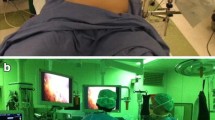Abstract
Background
Laparoscopic liver resection has been increasingly adopted worldwide as a result of the rapid advancement in surgical techniques and equipment. This study aims to determine the factors associated with and outcomes of open conversion after laparoscopic minor hepatectomy (LMH) based on a single center multi-surgeon experience.
Methods
This is a retrospective review of the first 147 consecutive LMH performed between 2006 and April 2014 at a single institution. Data on patient demographics, pathology results, perioperative outcomes, and operative results were collected. Factors associated with open conversion were analyzed via univariate analysis and a P value <.05 was considered statistically significant.
Results
LMH was performed for malignancy in 114 (77.6 %) patients of which hepatocellular carcinoma (n = 82) and colorectal metastases (n = 16) were the most common pathologies. Forty-one (27.9 %) patients had cirrhotic livers and 18 (15.7 %) had fibrotic livers. Fifty patients (44 %) had concomitant surgery in addition to LMH. Twenty (13.6 %) procedures required open conversion and the most common reason was for bleeding (n = 12). Twenty-five patients (17 %) experienced postoperative complications. Univariate analyses demonstrated that only individual surgeon volume (n ≤ 10 cases) [15 (24.2 %) vs 5 (5.9 %), P = .001] and institution volume (n ≤ 25 cases) [8 (32 %) vs 12 (9.8 %), P = .003] were factors associated with open conversion. Open conversion was significantly associated with increased intra-operative blood loss, increased intra-operative blood transfusion, increased postoperative morbidity, and longer postoperative stay.
Conclusions
Individual surgeon and institution volumes were important factors associated with open conversion after LMH. Open conversion after LMH resulted in poorer outcomes compared to procedures that were successfully completed laparoscopically.
Similar content being viewed by others
References
Buell JF, Cherqui D, Geller DA et al (2009) The international position on laparoscopic liver surgery. The Louisville statement, 2008. Ann Surg 250:825–830
Goh BK, Chui CH, Yap TL, Low Y, Lama TK, Alkouder G, Prasad S, Jacobsen AS (2005) Is early laparoscopic appendectomy feasible in children with acute appendicitis presenting with an appendiceal mass? A prospective study. J Pediatr Surg 40:1134–1137
Purkayastha S, Tilney HS, Georgiou P et al (2007) Laparoscopic cholecystectomy versus mini-laparotomy cholecystectomy: a meta-analysis of randomised control trials. Surg Endosc 21(8):1294–1300
Goh BK, Tan YH, Yip SK, Eng P, Cheng CW (2004) Outcome of patients undergoing laparoscopic adrenalectomy for primary hyperaldosteronism. JSLS 8(4):320–325
Reza MM, Blasco JA, Andradas E et al (2006) Systematic review of laparoscopic versus open surgery for colorectal cancer. Br J Surg 93(8):921–928
Koh YX, Chok AY, Zheng HL, Tan CS, Chow PK, Wong WK, Goh BK (2013) A systematic review and meta-analysis comparing laparoscopic versus open gastric resection for gastrointestinal stromal tumors of the stomach. Ann Surg Oncol 20(11):3549–3560
Cherqui D, Husson E, Hammoud R et al (2000) Laparoscopic liver resections: a feasibility study in 30 patients. Ann Surg 232:753–762
Vigano L, Laurent A, Tayar C et al (2009) The learning curve in laparoscopic liver resection. Improved feasibility and reproducibility. Ann Surg 250:772–782
Troisi RI, Montalti R, Limmen JG et al (2014) Risk factors and management of conversions to an open approach in laparoscopic liver resection: analysis of 265 consecutive cases. HPB 16:75–82
Nguyen KT, Gamblin TC, Geller DA (2009) World review of laparoscopic liver resection—2,804 patients. Ann Surg 250:831–841
Buell JF, Thomas MT, Rudich S et al (2008) Experirence with more than 500 minimally invasive hepatic procedures. Ann Surg 248:475–486
Koffron AJ, Auffenberg G, Kung R et al (2007) Evaluation of 300 minimally invasive liver resections at a single institution: less is more. Ann Surg 246:385–392
Cho JY, Han HS, Yoon YS et al (2009) Outcomes of laparoscopic liver resection for lesions located in the right side of the liver. Arch Surg 144:25–29
Rao A, Rao G, Ahmed I (2011) Laparoscopic left lateral liver resection should be a standard operation. Surg Endosc 25:1603–1610
Costi R, Scatton O, Haddad L et al (2012) Lessons learned from the first 100 laparoscopic liver resections: not delaying conversion may allow reduced blood loss and operative time. J Laparoendosc Adv Surg Tech 22(5):425–431
Belghiti J, Clavien PA, Gadzijev E et al (2000) The Brisbane 2,000 terminology of liver anatomy and resections. HPB 2(3):333–339
Dindo D, DeMartines N, Clavien PA (2004) Classification of surgical complications: a new proposal with evaluation in a cohort of 6,336 patients and results of a survey. Ann Surg 240:205–213
Goh BK, Lee LS, Chow PK (2014) Early laparoscopic resection of ruptured hepatocellular carcinoma. JSLS (in press)
Goh BK, Chow PK (2014) Early hand-assisted laparoscopic resection of ruptured hepatocellular carcinoma. JSLS (in press)
Cai X, Li Z, Zhang Y et al (2014) Laparoscopic liver resection and the learning curve: a 14-year, single-center experience. Surg Endosc 28:1334–1341
Long TC, Bac NH, Thuan ND et al (2014) Laparoscopic liver resection: 5-year experience at a single center. Surg Endosc 28(3):796–802
Bryant R, Laurent A, Tayar C et al (2009) Laparoscopic liver resection—understanding its role in current practice: the Henri Mondor Hospital Experience. Ann Surg 250:103–111
Disclosures
Drs. Brian K. P. Goh, C.Y. Chan, J. S. Wong, S.Y. Lee, V. T. Lee, P. C. Cheow, P. K. Chow, L. L. Ooi, Chung A. Y have no conflict of interest nor financial disclosures.
Author information
Authors and Affiliations
Corresponding author
Rights and permissions
About this article
Cite this article
Goh, B.K.P., Chan, CY., Wong, JS. et al. Factors associated with and outcomes of open conversion after laparoscopic minor hepatectomy: initial experience at a single institution. Surg Endosc 29, 2636–2642 (2015). https://doi.org/10.1007/s00464-014-3981-0
Received:
Accepted:
Published:
Issue Date:
DOI: https://doi.org/10.1007/s00464-014-3981-0



